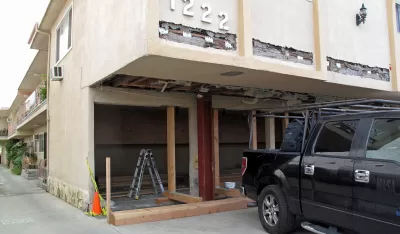A common building type is a major contributor to earthquake fatalities, prompting the Board of Supervisors to consider requiring safety upgrades on older buildings.

In the wake of the devastating earthquake in Turkey and Syria, the Los Angeles County Board of Supervisors voted to create rules for a mandatory retrofit of county-owned buildings and those located in unincorporated county areas. Rebecca Ellis and Rong-Gong Lin II report on the story for the Los Angeles Times.
The targeted buildings, called ‘non-ductile,’ involve a lack of sufficient steel reinforcement in their concrete frames, which can lead to catastrophic collapse. “That type of construction was deemed so unsafe that it was banned for future construction by the 1980s. But most local governments have done little to order older buildings be evaluated and strengthened if found to be deficient.” Non-ductile buildings have caused significant casualties in earthquakes around the world.
“The supervisors also ordered officials to create an inventory in unincorporated areas of all ‘soft-story’ residential buildings — structures vulnerable to come tumbling down in the next big earthquake,” such as the well-known L.A. ‘dingbats,’ a type of apartment building whose second story rests on thin supports above ground-level carports popular in the mid-20th century. In 2015, the city of Los Angeles took a similar action, going a step further to require seismic retrofits on thousands of non-ductile and soft-story buildings (not all of which have complied with the ordinance). Other California cities have implemented similar ordinances for non-ductile, soft-story, or both types of buildings.
FULL STORY: L.A. County moves to require quake retrofits as Turkey-Syria death toll exceeds 50,000

Alabama: Trump Terminates Settlements for Black Communities Harmed By Raw Sewage
Trump deemed the landmark civil rights agreement “illegal DEI and environmental justice policy.”

Planetizen Federal Action Tracker
A weekly monitor of how Trump’s orders and actions are impacting planners and planning in America.

Why Should We Subsidize Public Transportation?
Many public transit agencies face financial stress due to rising costs, declining fare revenue, and declining subsidies. Transit advocates must provide a strong business case for increasing public transit funding.

Understanding Road Diets
An explainer from Momentum highlights the advantages of reducing vehicle lanes in favor of more bike, transit, and pedestrian infrastructure.

New California Law Regulates Warehouse Pollution
A new law tightens building and emissions regulations for large distribution warehouses to mitigate air pollution and traffic in surrounding communities.

Phoenix Announces Opening Date for Light Rail Extension
The South Central extension will connect South Phoenix to downtown and other major hubs starting on June 7.
Urban Design for Planners 1: Software Tools
This six-course series explores essential urban design concepts using open source software and equips planners with the tools they need to participate fully in the urban design process.
Planning for Universal Design
Learn the tools for implementing Universal Design in planning regulations.
Caltrans
Smith Gee Studio
Institute for Housing and Urban Development Studies (IHS)
City of Grandview
Harvard GSD Executive Education
Toledo-Lucas County Plan Commissions
Salt Lake City
NYU Wagner Graduate School of Public Service





























